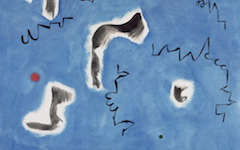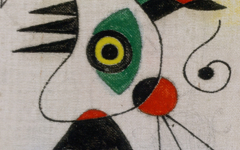Miró‘s Painting (1933)
In 1928 Joan Miró stopped signing his works, leading Anne Umland to remark in the catalog for a 2009 exhibition that he had renounced “one of the most traditional symbols of authenticity.”1 Yet, remarkably, no expert has noticed that he did not stop signing his works. He just started turning the entire canvas into an image of his signature, in one work after another. His name, after all, is quite significant for a painter given its close link to the Spanish verb, mirar: to look.
Take a 1933 canvas, simply titled Painting and read it from the bottom up. Try seeing the letters MIRÓ before moving on.
Click the next thumbnail to continue
....then the R somewhat resembling a hand-written lower-case r. Though it looks like an n to the first-time viewer, it is intended to be seen more like the r in his signature than as an r in font......
The title Painting seems inconsequential until you recognize that what Miróhas done is express in the simplest terms possible what poetic painting is about: the artist himself. In Miró's mind he has created a "painting" which, by definition, can only be a reflection of his own self. That is how we think too and he tells us so. For instance, we can only think of our spouse in terms of our own experience, thus making our image of her or him a reflection of ourself.
Surprisingly, even though Miró is well-known for inscribing the names of objects on his works, the inclusion of his own name as the central part of the composition has not been recognized (except by other artists and similar minds.) Yet, as Umland continued to note in the same catalog, Miró "had frequently devoted excruciating care to the rendering, scale, and placement of his name within the composition of the works."2
See other entries on how Miró painted his name into his art, including Miró's Potato,
More Works by Miró
Notes:
1. Joan Miró: Painting and Anti-Painting, 1927-1937 (New York: Museum of Modern Art) 2009, p. 10
2. ibid., p. 54
Original Publication Date on EPPH: 26 Jul 2010. | Updated: 0. © Simon Abrahams. Articles on this site are the copyright of Simon Abrahams. To use copyrighted material in print or other media for purposes beyond 'fair use', you must obtain permission from the copyright owner. Websites may link to this page without permission (please do) but may not reproduce the material on their own site without crediting Simon Abrahams and EPPH.








